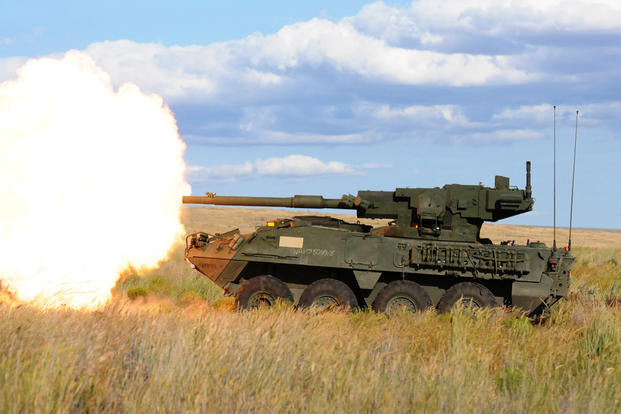The U.S. Army's 25th Infantry Division in Hawaii is reorganizing to convert a Stryker brigade into an infantry brigade with the loss of at least 1,200 positions, reflecting the difficult choices throughout the service in downsizing to meet budget demands.
At the same time, the division is switching out the OH-58 Kiowa scout helicopters in its Combat Aviation Brigade in exchange for 24 AH-64 Apache attack helicopters as part of the "Army's ongoing aviation restructure initiative," said Maj. Gen. Charles A. Flynn, the division commander. The two dozen Apaches were expected to arrive by ship at Pearl Harbor in April, he said.
"We were directed by the Army to do it" under the plan to cut active-duty end strength from the current 481,000 to 450,000 by fiscal 2018, Flynn said. "From my standpoint, the Army had to come up with some savings, and this is a decision made taking a look at the entire force structure," he said in a video briefing from Schofield Barracks in Hawaii to the Pentagon.
Flynn's main concern was making sure that "readiness doesn't drop while they're turning in equipment" as the division's 2nd Stryker Brigade Combat Team converts to an infantry brigade beginning in March. In the process, "we're going to lose about 1,200 slots out there, 1,200 spaces" from the total strength of the division, he said.
The fallout from the conversion will reverberate through the Army's structures. "We've got about 330 Strykers that we've got to divest ourselves from" while bringing in the equipment set for an infantry brigade, Flynn said.
Maj. Gen. Bret Daugherty, Washington state's adjutant general and commander of the Washington National Guard, said he was happy to be getting Flynn's Stryker Fighting Vehicles.
Back in July, when the Defense Department announced brigade realignments as part of the downsizing, the plan was to convert the Washington National Guard's 81st Armored Brigade Combat Team, which currently operates M1A1 Abrams tanks and Bradley Fighting Vehicles, into a Stryker Brigade Combat Team.
Daugherty said at the time, "This is a huge win for Washington state. Our tanks and Bradleys are critical for our federal mission. However, they're too heavy to move on our local roads, making them almost useless following a state disaster. The Strykers are a more mobile, versatile vehicle," he said.
Losing the Strykers will also mean that Flynn will have to send troops from the new unit to the Joint Readiness Center at Fort Polk, Louisiana, for extensive training to be "validated" as an infantry brigade.
The 25th ID's troop cuts and the conversion were mirrored at other Army posts. In the downsizing involved to get to 450,000 troops by the end of fiscal 2018, the service announced in July that Schofield Barracks was one of six installations that would lose more than 1,000 troops.
The others were Fort Benning, Georgia, 3,402 troops; Fort Hood, Texas, 3,350; Joint Base Elmendorf-Richardson, Alaska, 2,631; Joint Base Lewis-McChord, Washington, 1251; and Fort Bliss, Texas.
"These are incredibly difficult choices," Brig. Gen. Randy George, director of force management for the Army," said in announcing the cuts at a Pentagon news conference, "but the Army has to operate within the budget provided. Part of doing that is restructuring and reorganizing to be able to accomplish the Army's mission in the best manner possible."
In 2012, the active-duty Army had an end-strength of about 570,000 soldiers. At the end of fiscal 2016, troop strength is projected at 475,000; at the end of fiscal 2017, 460,000; and at the end of FY2018, 450,000.
The missions and commitments for the 25th Infantry Division will not diminish as the Army cuts end strength, Flynn said. The 2nd Squadron, 6th Cavalry Regiment, of the 25th Combat Aviation Brigade recently returned from a nine-month deployment to South Korea.
The division also has commitments to U.S. Central Command. A combat service support battalion from the division is currently deployed to Kuwait, Flynn said.
However, the 25th ID's primary mission was to bring an Army ground presence to the Obama administration's so-called "Pacific pivot," the rebalance of U.S. forces to the Asia-Pacific region.
"With the capabilities we have here in the 25th Infantry Division, we're a pretty visible presence in the rebalance to the Pacific," Flynn said.
Under Gen. Vincent Brooks, commander of the U.S. Army Pacific, the Army has embarked on a series of "Pacific Pathways" deployments to the region involving about 1,000 troops for three months for joint exercises and training with regional partners. One Pacific Pathways deployment occurred in 2014 and there were three last year.
Three are planned for this year, with one currently beginning for about 1,000 troops from the 25th ID to Thailand, South Korea and the Philippines, Flynn said. In all, the Pacific Pathways deployments will go to nine countries in the region this year, he said, "allowing Army forces to be constantly in motion west of the international dateline."
-- Richard Sisk can be reached at Richard.Sisk@Military.com





























